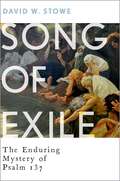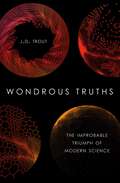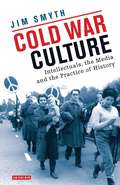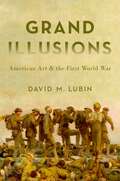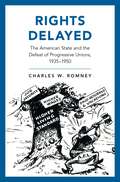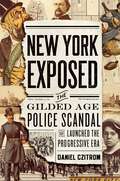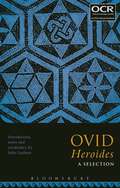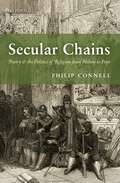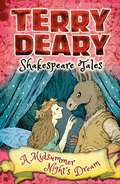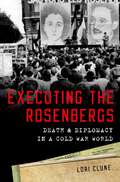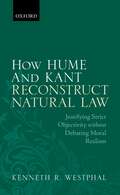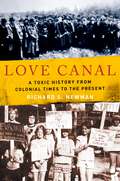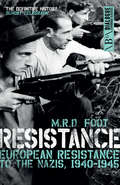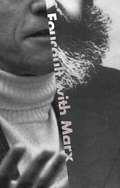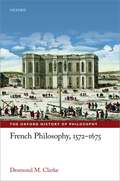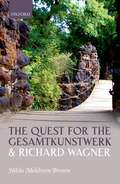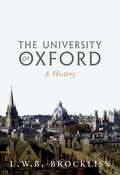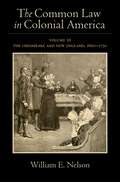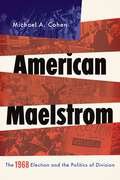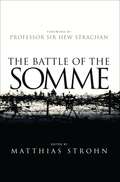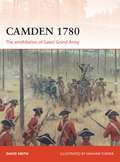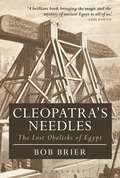- Table View
- List View
Song of Exile: The Enduring Mystery of Psalm 137
by David W. StoweOft-referenced and frequently set to music, Psalm 137 - which begins "By the rivers of Babylon, there we sat down, yea, we wept, when we remembered Zion" - has become something of a cultural touchstone for music and Christianity across the Atlantic world. It has been a top single more than once in the 20th century, from Don McLean's haunting Anglo-American folk cover to Boney M's West Indian disco mix. In Song of Exile, David Stowe uses a wide-ranging, interdisciplinary approach that combines personal interviews, historical overview, and textual analysis to demonstrate the psalm's enduring place in popular culture. The line that begins Psalm 137 - one of the most lyrical of the Hebrew Bible - has been used since its genesis to evoke the grief and protest of exiled, displaced, or marginalized communities. Despite the psalm's popularity, little has been written about its reception during the more than 2,500 years since the Babylonian exile. Stowe locates its use in the American Revolution and the Civil Rights movement, and internationally by anti-colonial Jamaican Rastafari and immigrants from Ireland, Korea, and Cuba. He studies musical references ranging from the Melodians' Rivers of Babylon to the score in Kazakh film Tulpan. Stowe concludes by exploring the presence and absence in modern culture of the often-ignored final words: "Happy shall he be, that taketh and dasheth thy little ones against the stones." Usually excised from liturgy and forgotten by scholars, Stowe finds these words echoed in modern occurrences of genocide and ethnic cleansing, and more generally in the culture of vengeance that has existed in North America from the earliest conflicts with Native Americans. Based on numerous interviews with musicians, theologians, and writers, Stowe reconstructs the rich and varied reception history of this widely used, yet mysterious, text.
Wondrous Truths: The Improbable Triumph of Modern Science
by J.D. TroutA fresh, daring, and genuine alternative to the traditional story of scientific progress Explaining the world around us, and the life within it, is one of the most uniquely human drives, and the most celebrated activity of science. Good explanations are what provide accurate causal accounts of the things we wonder at, but explanation's earthly origins haven't grounded it: we have used it to account for the grandest and most wondrous mysteries in the natural world. Explanations give us a sense of understanding, but an explanation that feels right doesn't mean it is true. For every true explanation, there is a false one that feels just as good. A good theory's explanations, though, have a much easier path to truth. This push for good explanations elevated science from medieval alchemy to electro-chemistry, or a pre-inertial physics to the forces underlying nanoparticles. And though the attempt to explain has existed as long as we have been able to wonder, a science timeline from pre-history to the present will reveal a steep curve of theoretical discovery that explodes around 1600, primarily in the West. Ranging over neuroscience, psychology, history, and policy, Wondrous Truths answers two fundamental questions-Why did science progress in the West? And why so quickly? J.D. Trout's answers are surprising. His central idea is that Western science rose above all others because it hit upon successive theories that were approximately true through an awkward assortment of accident and luck, geography and personal idiosyncrasy. Of course, intellectual ingenuity partially accounts for this persistent drive forward. But so too does the persistence of the objects of wonder. Wondrous Truths recovers the majesty of science, and provides a startling new look at the grand sweep of its biggest ideas.
Cold War Culture: Intellectuals, the Media and the Practice of History
by Jim SmythBritain in the 1950s had a distinctive political and intellectual climate. It was the age of Keynesianism, of welfare state consensus, incipient consumerism, and, to its detractors - the so-called 'Angry Young Men' and the emergent New Left - a new age of complacency. While Prime Minister Harold Macmillan famously remarked that 'most of our people have never had it so good', the playwright John Osborne lamented that 'there aren't any good, brave causes left'.Philosophers, political scientists, economists and historians embraced the supposed 'end of ideology' and fetishized 'value-free' technique and analysis. This turn is best understood in the context of the cultural Cold War in which 'ideology' served as shorthand for Marxist, but it also drew on the rich resources and traditions of English empiricism and a Burkean scepticism about abstract theory in general. Ironically, cultural critics and historians such as Raymond Williams and E.P. Thompson showed at this time that the thick catalogue of English moral, aesthetic and social critique could also be put to altogether different purposes.Jim Smyth here shows that, despite being allergic to McCarthy-style vulgarity, British intellectuals in the 1950s operated within powerful Cold War paradigms all the same.
Grand Illusions: American Art and the First World War
by David M. LubinA vivid, engaging account of the artists and artworks that sought to make sense of America's first total war, Grand Illusions takes readers on a compelling journey through the major historical events leading up to and beyond US involvement in WWI to discover the vast and pervasive influence of the conflict on American visual culture. David M. Lubin presents a highly original examination of the era's fine arts and entertainment to show how they ranged from patriotic idealism to profound disillusionment. In stylishly written chapters, Lubin assesses the war's impact on two dozen painters, designers, photographers, and filmmakers from 1914 to 1933. He considers well-known figures such as Marcel Duchamp, John Singer Sargent, D. W. Griffith, and the African American outsider artist Horace Pippin while resurrecting forgotten artists such as the mask-maker Anna Coleman Ladd, the sculptor Gertrude Vanderbilt Whitney, and the combat artist Claggett Wilson. The book is liberally furnished with illustrations from epoch-defining posters, paintings, photographs, and films. Armed with rich cultural-historical details and an interdisciplinary narrative approach, David Lubin creatively upends traditional understandings of the Great War's effects on the visual arts in America.
Rights Delayed: The American State and the Defeat of Progressive Unions, 1935-1950
by Charles W. RomneyProgressive unions flourished in the 1930s by working alongside federal agencies created during the New Deal. Yet in 1950, few progressive unions remained. Why? Most scholars point to domestic anti-communism and southern conservatives in Congress as the forces that diminished the New Deal state, eliminated progressive unions, and destroyed the radical potential of American liberalism. Rights Delayed: The American State and the Defeat of Progressive Unions argues that anti-communism and Congressional conservatism merely intensified the main reason for the decline of progressive unions: the New Deal state's focus on legal procedure. Initially, progressive unions thrived by embracing the procedural culture of New Deal agencies and the wartime American state. Between 1935 and 1945, unions mastered the complex rules of the NLRB and other federal entities by working with government officials. In 1946 and 1947, however, the emphasis on legal procedure made the federal state too slow to combat potentially illegal cooperation between employers and the Teamsters. Workers who supported progressive unions rallied around procedural language to stop what they considered Teamster collusion, but found themselves dependent on an ineffective federal state. The state became even less able to protect employees belonging to left-led unions after the Taft-Hartley Act's anti-communist provisions-and decisions by union leaders-limited access to the NLRB's procedures. From 1946 until 1950, progressive unions withered and eventually disappeared from the Pacific canneries as the unions failed to pay the cost of legal representation before the NLRB. Workers supporting progressive unions had embraced procedural language to claim their rights, but by 1950, those workers discovered that their rights had vanished in an endless legal discourse.
New York Exposed: The Gilded Age Police Scandal that Launched the Progressive Era
by Daniel CzitromOn a Sunday morning in early 1892, Reverend Dr. Charles H. Parkhurst ascended to his pulpit at the Madison Square Presbyterian Church in New York and delivered one of the most explosive sermons in the city's history. Municipal life, he charged, was morally corrupt. Vice was rampant. And the city's police force and its Tammany Hall politicians were"a lying, perjured, rum-soaked, and libidinous lot." Denounced by city and police officials as a self-righteous "blatherskite," Parkhurst resolved to prove his case. The bespectacled minister descended his pulpit and in disguise visited gin joints and brothels, taking notes and gathering evidence. Two years later, his findings forced the New York State Senate to investigate the New York Police Department. The Lexow Committee heard testimony from nearly 700 witnesses, who revealed in shocking-and headline-dominating-detail just how deeply the NYPD was involved in, and benefitted from, the vice economy. Parkhurst's campaign had kick-started the Progressive Movement. New York Exposed offers a narrative history of the first major crusade to clean up Gotham. Daniel Czitrom does full justice to this spellbinding story by telling it within the larger contexts of national politics, poverty, patronage, vote fraud and vote suppression, and police violence. The effort to root out corrupt cops and crooked politicians morphed into something much more profound: a public reckoning over what New York-and the American city-had become since the Civil War. Animated by as vivid a cast as New York has ever produced, the book's key characters include Police Superintendent Thomas Byrnes and Inspector Alexander "Clubber" Williams, the nation's most famous cops, as well as anarchist revolutionary Emma Goldman, the zealous prosecutor John W. Goff, and an array of politicos, immigrant leaders, labor bosses, prostitutes, show-business entrepreneurs, counterfeiters, and reformers and muckrakers determined to change business as usual. New York Exposed offers an unforgettable portrait of a city in a truly transformative moment.
Ovid Heroides: A Selection
by John GodwinThis is the OCR-endorsed publication from Bloomsbury for the Latin A-Level (Group 4) prescription of Ovid's Heroides, giving full Latin text, commentary and vocabulary for Heroides VI, lines 1–100 and 127–64, and X, lines 1–76 and 119–50. A detailed introduction covers the prescribed text to be read in English, placing the poems in their Roman literary context.The heroines of the Heroides are women in love who can do nothing but write sad verse letters to their faithless lovers across the sea. They tell their stories and express their feelings in poetry of great power and psychological subtlety. Hypsipyle (in VI) and Ariadne (in X) are feminists before feminism, royal ladies who are slaves to their passion – these women are given a voice by Ovid in poetry which is at once simple and sophisticated, heartfelt and yet also full of irony and literary resonance.
Secular Chains: Poetry and the Politics of Religion from Milton to Pope
by Philip ConnellSecular Chains offers an original and richly contextualized account of the relationship between poetry and religious controversy between 1649 and 1745. This was a period of political conflict and intellectual upheaval, in which traditional sources of spiritual authority were variously challenged and transformed. This study reveals the importance of English literary culture for our understanding of this process, and throws new light on the dynamics of change and continuity between the puritan revolution and the early Enlightenment. Based on extensive research in both printed and manuscript sources, the book combines detailed case studies of major literary figures with a sustained historical narrative linking the republican moment of the 1650s, the conflicts and crises of the Restoration, and the ecclesiastical politics of the early eighteenth century. Milton and Dryden provide the principal focus of the first three chapters, which explore the divisive issue of church settlement in the work of both writers, together with the increasingly prominent rhetoric of anti-clericalism and irreligion in the poetry and polemics of the later seventeenth century. Subsequent chapters extend the book's argument to the embattled condition of the Church of England in the decades after 1688, and the significant contribution of contemporary literary culture to a range of religious and philosophical argument, from heterodox free-thinking to Newtonian natural theology. Secular Chains demonstrates the close and continued relationship between poetry and religious politics in the age of Milton and Pope, and provides a new framework for understanding this complex and turbulent period in English literary history.
Shakespeare Tales: A Midsummer Night's Dream (Shakespeare Tales)
by Terry DearyFrom the bestselling author of Horrible Histories...Molly loves travelling with Shakespeare's theatre company but the jester, Armin, keeps picking on her and faithful donkey, Dolly. Can she keep Armin away from Dolly and stay with the theatre company? Meanwhile, on stage, Helena wants revenge on Hermia, Lysander wants revenge on Demetrius and the fairy queen Titania has fallen in love with a donkey! Terry Deary's Shakespeare Tales explore the fascinating world of William Shakespeare through the eyes of children who could have lived at the time. Join master storyteller Terry Deary for a trip back in time to Shakespeare's travelling theatre company and a laugh-out loud comedy. This edition features notes for the reader to help extend learning and exploration of the historical period.
Shakespeare Tales: Macbeth (Shakespeare Tales)
by Terry DearyFrom the bestselling author of Horrible Histories...Orphaned pot-girl Mary has buckets of stage blood to clear up under the horrible gaze of Master 'Foulbrew'. Can she find a way to escape her revolting master? Meanwhile, on stage, Lady Macbeth wants to be queen but old King Duncan is on the throne. The witches say Lord Macbeth will rule, so ghosts, treason and blood are bound to follow. Terry Deary's Shakespeare Tales explore the fascinating world of William Shakespeare through the eyes of children who could have lived at the time. Join master storyteller Terry Deary for a trip back in time to Shakespeare's England and a gripping adventure. This edition features notes for the reader to help extend learning and exploration of the historical period.
Executing the Rosenbergs: Death and Diplomacy in a Cold War World
by Lori CluneIn 1950, Julius and Ethel Rosenberg were arrested for allegedly passing information about the atomic bomb to the Soviet Union, an affair FBI Director J. Edgar Hoover labeled the "crime of the century." Their case became an international sensation, inspiring petitions, letters of support, newspaper editorials, and protests in countries around the world. Nevertheless, the Rosenbergs were executed after years of appeals, making them the only civilians ever put to death for conspiracy-related activities. Yet even after their executions, protests continued. The Rosenberg case quickly transformed into legend, while the media spotlight shifted to their two orphaned sons. In Executing the Rosenbergs, Lori Clune demonstrates that the Rosenberg case played a pivotal role in the world's perception of the United States. Based on newly discovered documents from the State Department, Clune narrates the widespread dissent against the Rosenberg decision in 80 cities and 48 countries. Even as the Truman and Eisenhower administrations attempted to turn the case into pro-democracy propaganda, U.S. allies and potential allies questioned whether the United States had the moral authority to win the Cold War. Meanwhile, the death of Stalin in 1953 also raised the stakes of the executions; without a clear hero and villain, the struggle between democracy and communism shifted into morally ambiguous terrain. Transcending questions of guilt or innocence, Clune weaves the case -and its aftermath -into the fabric of the Cold War, revealing its far-reaching global effects. An original approach to one of the most fascinating episodes in Cold War history, Executing the Rosenbergs broadens a quintessentially American story into a global one.
How Hume and Kant Reconstruct Natural Law: Justifying Strict Objectivity without Debating Moral Realism
by Kenneth R. WestphalKenneth R. Westphal presents an original interpretation of Hume's and Kant's moral philosophies, the differences between which are prominent in current philosophical accounts. Westphal argues that focussing on these differences, however, occludes a decisive, shared achievement: a distinctive constructivist method to identify basic moral principles and to justify their strict objectivity, without invoking moral realism nor moral anti-realism or irrealism. Their constructivism is based on Hume's key insight that 'though the laws of justice are artificial, they are not arbitrary'. Arbitrariness in basic moral principles is avoided by starting with fundamental problems of social coördination which concern outward behaviour and physiological needs; basic principles of justice are artificial because solving those problems does not require appeal to moral realism (nor to moral anti-realism). Instead, moral cognitivism is preserved by identifying sufficient justifying reasons, which can be addressed to all parties, for the minimum sufficient legitimate principles and institutions required to provide and protect basic forms of social coördination (including verbal behaviour). Hume first develops this kind of constructivism for basic property rights and for government. Kant greatly refines Hume's construction of justice within his 'metaphysical principles of justice', whilst preserving the core model of Hume's innovative constructivism. Hume's and Kant's constructivism avoids the conventionalist and relativist tendencies latent if not explicit in contemporary forms of moral constructivism.
Love Canal: A Toxic History from Colonial Times to the Present
by Richard S. NewmanIn the summer of 1978, residents of Love Canal, a suburban development in Niagara Falls, NY, began protesting against the leaking toxic waste dump in their midst-a sixteen-acre site containing 100,000 barrels of chemical waste that anchored their neighborhood. Initially seeking evacuation, area activists soon found that they were engaged in a far larger battle over the meaning of America's industrial past and its environmental future. The Love Canal protest movement inaugurated the era of grassroots environmentalism, spawning new anti-toxics laws and new models of ecological protest. Historian Richard S. Newman examines the Love Canal crisis through the area's broader landscape, detailing the way this ever-contentious region has been used, altered, and understood from the colonial era to the present day. Newman journeys into colonial land use battles between Native Americans and European settlers, 19th-century utopian city planning, the rise of the American chemical industry in the 20th century, the transformation of environmental activism in the 1970s, and the memory of environmental disasters in our own time. In an era of hydrofracking and renewed concern about nuclear waste disposal, Love Canal remains relevant. It is only by starting at the very beginning of the site's environmental history that we can understand the road to a hazardous waste crisis in the 1970s-and to the global environmental justice movement it sparked.
Resistance: European Resistance to the Nazis, 1940-1945
by M. R. Foot"If you who read this can say, I am not under fire; I am not under torture; I am not on the run; if I hear a noise at six in the morning, I know it is a neighbour or a milkman, not the secret police; no one in my country is arrested and held without prompt charge and trial... then you owe it, in a larger degree than most historians have so far allowed, to the resistance that occupied Europe put up to Hitler." An instant classic upon its initial publication in 1976, this fluent and persuasive book was the first to analyse the whole field of wartime resistance to the Nazis in Europe, to explain what resisters could and could not do, and to assess whether they achieved their aims. It is a truly epic theme, with its drama of intelligence, deception, escape and subversion. In gathering the threads of this important narrative into the fabric of a single volume, M. R. D. Foot, one of the most distinguished historians of his time, achieved a work of gripping and major significance.
Foucault with Marx
by Jacques BidetWith this timely commitment, Jacques Bidet unites the theories of arguably the world's two greatest emancipatory political thinkers. In this far-reaching and decisive text, Bidet examines Marxian and Foucauldian criticisms of capitalist modernity.For Marx, the intersection between capital and the market is crucial, while for Foucault, the organizational aspects of capital are what really matter. According to Marx, the ruling class is identified with property; with Foucault, it is the managers who hold power and knowledge that rule. Bidet identifies these two sides of capitalist modernity as 'market' and 'organization', showing that each leads to specific forms of social conflict; against exploitation and austerity, over wages and pensions on the one hand, and against forms of 'medical' and work-based discipline, control of bodies and prisons on the other.Bidet's impetus and clarity however serve a greater purpose: uniting two souls of critical social theory, in order to overcome what has become an age-long separation between the 'old left' and the 'new social movements'.
French Philosophy, 1572-1675 (The Oxford History of Philosophy)
by Desmond M. ClarkeDesmond M. Clarke presents a thematic history of French philosophy from the middle of the sixteenth century to the beginning of Louis XIV's reign. While the traditional philosophy of the schools was taught throughout this period by authors who have faded into permanent obscurity, a whole generation of writers who were not professional philosophers—some of whom never even attended a school or college—addressed issues that were prominent in French public life. Clarke explores such topics as the novel political theory espoused by monarchomachs, such as Bèze and Hotman, against Bodin's account of absolute sovereignty; the scepticism of Montaigne, Charron, and Sanches; the ethical discussions of Du Vair, Gassendi, and Pascal; innovations in natural philosophy that were inspired by Mersenne and Descartes and implemened by members of the Académie royale des sciences; theories of the human mind from Jean de Silhon to Cureau de la Chambre and Descartes; and the novel arguments in support of women's education and equality that were launched by De Gournay, Du Bosc, Van Schurman and Poulain de la Barre. The writers involved were lawyers, political leaders, theologians, and independent scholars and they acknowledged, almost unanimously, the authority of the Bible as a source of knowledge that was claimed to be more reliable than the fragile powers of human understanding. Since they could not agree, however, on which books of the Bible were canonical or how that should be understood, their discussions raised questions about faith and reason that mirrored those involved in the infamous Galileo affair.
The Quest for the Gesamtkunstwerk and Richard Wagner
by Hilda Meldrum BrownThe Gesamtkunstwerk ('total work of art'), once a key concept in Wagner studies, has become problematic. This book sheds light on this conundrum by first tracing the development of the concept in the 19th century through selected examples, some of which include combinations of different art forms. It then focuses on the culmination of the Gesamtkunstwerk in Wagner's theories and in the practice of his late music dramas, of which Der Ring des Nibelungen is the most complete representation. Finally, the book contrasts the view of the Ring as a fusion of dramatic text and music with the 20th century trend towards Deconstruction in Wagnerian productions and the importance of Régie. Against this trend a case is made here for a fresh critical approach and a reconsideration of the nature and basis for the fundamental unity which has hitherto been widely perceived in Wagner's Ring. Approaches through Leitmotiv alone are no longer acceptable. However, in conjunction with another principle, Moment, which Wagner insisted on combining with Motive, these can be ingeniously 'staged' and steered to dramatic ends by means of musical dynamics and expressive devices such as accumulation. Analysis of the two Erda scenes demonstrates how this complex combination of resources acts as a powerful means of fusion of the musical and dramatic elements in the Ring and confirms its status as a Gesamtkunstwerk.
The University of Oxford: A History
by L.W.B. BrocklissThis fresh and readable account gives a complete history of the University of Oxford, from its beginnings in the eleventh century to the present day. Written by one of the leading authorities on the history of universities internationally, it traces Oxford's improbable rise from provincial backwater to one of the world's leading centres of research and teaching. Laurence Brockliss sees Oxford's history as one of discontinuity as much as continuity, describing it in four distinct parts. First he explores Oxford as 'The Catholic University' in the centuries before the Reformation, when it was principally a clerical studium serving the needs of the Western church. Then as 'The Anglican University', in the years from 1534 to 1845 when Oxford was confessionally closed to other religions, it trained the next generation of ministers of the Church of England, and acted as a finishing school for the sons of the gentry and the well-to-do. After 1845 'The Imperial University' saw the emergence over the following century of a new Oxford - a university which was still elitist but now non-confessional; became open to women as well as men; took students from all round the Empire; and was held together at least until 1914 by a novel concept of Christian service. The final part, 'The World University', takes the story forward from 1945 to the present day, and describes Oxford's development as a modern meritocratic and secular university with an ever-growing commitment to high-quality academic research. Throughout the book, Oxford's history is placed in the wider context of the history of higher education in the UK, Europe, and the world. This helps to show how singular Oxford's evolution has been: a story not of entitlement but of hard work, difficult decisions, and a creative use of limited resources and advantages to keep its destiny in its own hands.
Arab Cinema Travels: Transnational Syria, Palestine, Dubai and Beyond (Cultural Histories of Cinema)
by Kay DickinsonExploring the impact of travel on Arab cinema, Kay Dickinson reveals how the cinemas of Syria, Palestine and Dubai have been shaped by the history and politics of international circulation. This compelling book offers fresh insights into film, mobility and the Middle East.
The Common Law in Colonial America: Volume III: The Chesapeake and New England, 1660-1750
by William E. NelsonIn a projected four-volume series, The Common Law in Colonial America, William E. Nelson will show how the legal systems of Britain's thirteen North American colonies, which were initially established in response to divergent political, economic, and religious initiatives, slowly converged until it became possible by the 1770s to imagine that all thirteen participated in a common American legal order, which diverged in its details but differed far more substantially from English common law. Volume three, The Chesapeake and New England, 1660-1750, reveals how Virginia, which was founded to earn profit, and Massachusetts, which was founded for Puritan religious ends, had both adopted the common law by the mid-eighteenth century and begun to converge toward a common American legal model. The law in the other New England colonies, Nelson argues, although it was distinctive in some respects, gravitated toward the Massachusetts model, while Maryland's law gravitated toward that of Virginia.
Thetford Grammar School: Fourteen Centuries of Education
by David SeymourThetford Grammar School's formation is shrouded in mystery, but it may date back as far as 631. First re-founded by the Bishop of Norwich in 1114, the school was revitalised following the dissolution of the monasteries, and firmly re-established by an Act of Parliament in 1610 and then by a new foundation document in 1876. A Girls' School was set up alongside the ancient Boys' School in 1888 and both schools spent the middle years of the twentieth century as county council grammar schools, before their re-foundation as a co-educational independent school in 1981. Written to coincide with the 450th anniversary of Thetford Grammar School's re-founding and drawing on the school's archives, David Seymour discusses four and a half centuries of governance, pupils, headteachers, ushers and assistant teachers, phases of building, and the development of the curriculum.
American Maelstrom: The 1968 Election and the Politics of Division (Pivotal Moments in World History)
by Michael A. CohenIn his presidential inaugural address of January 1965, Lyndon B. Johnson offered an uplifting vision for America, one that would end poverty and racial injustice. Elected in a landslide over the conservative Republican Barry Goldwater and bolstered by the so-called liberal consensus, economic prosperity, and a strong wave of nostalgia for his martyred predecessor, John F. Kennedy, Johnson announced the most ambitious government agenda in decades. Three years later, everything had changed. Johnson's approval ratings had plummeted; the liberal consensus was shattered; the war in Vietnam splintered the nation; and the politics of civil rights had created a fierce white backlash. A report from the National Committee for an Effective Congress warned of a "national nervous breakdown." The election of 1968 was immediately caught up in a swirl of powerful forces, and the nine men who sought the nation's highest office that year attempted to ride them to victory-or merely survive them. On the Democratic side, Eugene McCarthy energized the anti-war movement; George Wallace spoke to the working-class white backlash; Robert Kennedy took on the mantle of his slain brother. Entangled in Vietnam, Johnson, stunningly, opted not to run again, scrambling the odds. On the Republican side, 1968 saw the vindication of Richard Nixon, who outhustled Nelson Rockefeller, Ronald Reagan, and George Romney by navigating between the conservative and moderate wings of the Republican Party. The assassinations of the first Martin Luther King, Jr., and then Kennedy, seemed to push the country to the brink of chaos, a chaos reflected in the Democratic Convention in Chicago, a televised horror show. Vice President Hubert Humphrey emerged as the nominee, and, finally liberating himself from Johnson's grip, nearly overcame the lead long enjoyed by Nixon, who, by exploiting division and channeling the national yearning for order, would be the last man standing. In American Maelstrom, Michael A. Cohen captures the full drama of this watershed election, establishing 1968 as the hinge between the decline of political liberalism, the ascendancy of conservative populism, and the rise of anti-governmental attitudes that continue to dominate the nation's political discourse. In this sweeping and immersive book, equal parts compelling analysis and thrilling narrative, Cohen takes us to the very source of our modern politics of division.
The Battle of the Somme
by Hew Strachan Jonathan Krause Matthias StrohnPublished to coincide with the centenary commemoration of the battle of the Somme, this new study comprises 12 separate articles written by some of the foremost military historians, each of whom looks at a specific aspect of the battle. Focusing on key aspects of the British, French and German forces, overall strategic and tactical impacts of the battle and with an introduction by renowned World War I scholar Professor Sir Hew Strachan, The Battle of the Somme is a timely collection of the latest research and analysis of the battle.The terrors of the Somme have largely come to embody trench warfare on the Western Front in the modern imagination, but this new book looks beyond the horrendous conditions and staggering casualty rates to provide new, insightful research on one of the most pivotal battles of the war.
Camden 1780: The annihilation of Gates’ Grand Army (Campaign #292)
by Graham Turner David SmithAs the American Revolution continued, the British refocused their fight on the southern colonies in the hopes of triggering an outbreak of loyalism that would sweep the rebels aside. Under Sir Henry Clinton they captured Savannah at the end of 1778, and Charleston in May 1780, with Lord Cornwallis being left in command with just 8,500 men under him. Too thinly spread to guard the 15,000 square miles he was responsible for, Cornwallis went on the offensive, invading North Carolina and using Camden as a launch pad. This new history reveals how Cornwallis was able to use his aggressive strategy to great effect and how the overconfidence of the re-formed American forces under Horatio Gates was to result in a shocking defeat on the night of 15 August 1780 – a defeat that would allow Cornwallis to push deep into North Carolina the following year, where he would only be stopped by the American victory at Yorktown.
Cleopatra's Needles: The Lost Obelisks of Egypt (Bloomsbury Egyptology)
by Bob BrierIn the half-century between 1831 and 1881 three massive obelisks left Egypt for new lands. Prior to these journeys, the last large obelisk moved was the Vatican obelisk in 1586 – one of the great engineering achievements of the Renaissance. Roman emperors moved more than a dozen, but left no records of how they did it. The nineteenth-century engineers entrusted with transporting the obelisks across oceans had to invent new methods, and they were far from certain that they would work. As the three obelisks, bound for Paris, London and New York, sailed towards their new homes, the world held its breath. Newspapers reported the obelisks' daily progress, complete with dramatic illustrations of the heroic deeds of the engineers and crews struggling under nearly impossible conditions. When the obelisks finally arrived safely in their new homes, bands played Cleopatra's Needle Waltz and silver obelisk pencils dangled from fashionable ladies' necks. This turbulent era, caught up in obelisk mania, is recreated by Bob Brier in all its glory. Amid astounding tales of engineering dexterity and naval endurance, the individuals involved in transporting the obelisks and receiving them in their future homes are brought to life through their letters and diaries, newspaper articles and illustrations. Written by a renowned Egyptologist and author, this compelling book will fascinate all those interested in Egypt, its iconic monuments and the history of great endeavour.
